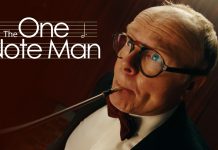Jordan Anstatt reflects on the cause and effect of domestic violence in his powerful short film MAX IS BLEEDING.
Film And TV Now spoke with the film-maker about the short.
FILM AND TV NOW: The film subtly but effectively represents the effect of domestic violence without resorting to too much graphic detail. What was the start off point for the short?
JORDAN ANSTATT: One thing that interested me about Louis Lagayette’s original script was how he built tension through mystery. We had a lot of discussions about what details we needed for clarity versus what we could leave off-screen to build tension.
As the director, I wanted to take a psychologically realistic approach with the acting, so Louis and I played with various forms of violence and restraint in the writing. We paid close attention to Sam and tried to give him his own depth and life as a character, so we started to see that Sam was a pretty watchful, careful guy.
It’s more interesting that way anyway—it makes it hard for Courtney to get where she needs to go if Sam is smart. That means that he does what he has to do, but he’s smart enough not to blow his cover. What you see in the film is a culmination of those considerations.
FTVN: In terms of your own output, what tends to be the creative spark for your film-making endeavours?
JA: As someone who’s focused on narrative film-making, I usually begin with an image that seems to have some sort of story built into it—a sense of movement and character and sound.
Even if it’s a series of seemingly scattered images, I wait for a story to emerge. If a character I’m envisioning starts to move or speak, that’s really fascinating to me. But it has to start with the image—character or dialogue or plot without any image doesn’t even make it onto the “ideas” page on my phone.
I didn’t write Max is Bleeding, but it’s the same thing—when I read the script, I could see and hear the world, feel the textures and tones of it. That gets me hyped.
FTVN: Tell us about your cast
JA: Chloe Sirene carried the film on her shoulders. She was completely dedicated to Courtney and brought everything we talked about in prep to another level. She basically created her own world and lived in it while we shot, so when we were rolling,
I was often trying to step back and capture that inner world. Matias Bonino was the perfect match and stepped up to the plate as Sam, the boyfriend. Matias is such a sweet guy, so it was stunning to see him dive into this dark role with depth and complexity. Ameerah Briggs and Julie Reifers were an amazing team as the hospital staff—they let me try improv with them and rehearse. I was grateful that everyone took their role seriously so that we could keep the film truthful.
FTVN: Tell us about your production team
JA: Pasha Gambourg approached me early on to produce—he heard I wanted to frame this as a Jersey story and offered a lot of resources up front, especially locations. I have no idea how we’d have stuck to our budget without him and his brother Roman, who provided the main office for the shoot.
Harrison Perkins was also a producer and my AD, so we worked together heavily all the way through the shoot—he’s always steady and helps me move at an even pace. Molly Evans introduced us to Matt Lipke, our animal wrangler and Ghost, the dog who played Max. I had a lot of fun working with them on stunts and little moments.
I knew this would be a perfect project for Niko Feldman, our DP, who helped bring some grit and naturalism to the look of the film. I like to shoot on location and make things seem real for myself, but that can add a lot of pressure and constraints. Everyone—the whole team—helped make the most of what little resources we had. Maybe I was the only one, but at the end of the shoot, I wanted to keep going!
FTVN: How long did it take to shoot and where did you shoot?
JA: We shot for three full days. Two of those days were in Fort Lee, NJ for the office scenes and one day was at Columbia University for the “intake room” location, which is actually nowhere near the other parts of the office.
Harrison helped me stitch it all together, schedule-wise, especially since we only had a few hours to shoot all of Ghost’s coverage. For the driving scene, we just circled the neighborhood near the office location—I’m sure the residents were surprised we were there. It was the perfect quiet, suburban street.
FTVN: How did you raise finance for the short?
JA: We’re still working on that—I reached out to about fifteen domestic violence organizations for support before the film was finished but haven’t found any partners yet, so I’m pivoting to try and find distribution for the film.
My hope is to sell it in a way that will allow it to educate people and reach a wider audience—domestic violence has been up since the beginning of the pandemic. Hopefully, we’ll find partners to pay the film back and get it where it needs to go in order to make a real impact.
FTVN: Did you rehearse much with the actors beforehand and what was their own personal reaction to the short itself?
JA: I did multiple rehearsals with Chloe and Matias that solidified the direction of the dialogue-heavy scenes and helped shape the final script. One of the hardest things was finding the tone for the performances—making it real and charged but not giving in to cliches or generally overdoing it.
In rehearsals, I found that the context of being in a public space gave us an added layer of restraint that worked. Ameerah and Julie also let me rehearse with them. We did improv that opened my eyes to what their scenes could become. I didn’t let Ameerah and Julie meet Chloe and Matias before shooting, though—I wanted them to be genuine strangers. I’m happy to report that they all enjoyed both the shooting process and the final film.
FTVN: Given the subject matter, are there plans to show it to schools, universities and women’s refuge charities as a moral point of reference?
JA: That’s my hope, no doubt. Since it’s had its festival debut and received positive responses, I’m aiming to give it a longer life in terms of education and outreach. I learned a lot from making it—both on an informational level and a personal one. I hope others can, too.
FTVN: What issues and themes are you keen to explore in your future work?
JA: I hope to continue to explore anxiety in my work. Anxiety works for both comedy and drama, so there’s a lot of ways to tackle it.
Lately I’ve been writing within worlds I’m more directly familiar with, like religion and skateboarding, but those are just contexts for other themes I enjoy exploring. Half the time, I realize why I’m telling a story after I’m way into the process, so I also like to keep some mystery alive and do what feels right even if I don’t know why.
FTVN: Would you like to expand MAX IS BLEEDING into a feature subject?
JA: I would do it, or something like it, as a feature film. I haven’t talked much to Louis about that, but my guess is that he’d be down. My directing prep included a lot of research and backstory creation, so I’m aware of what’s not being told in Max is Bleeding.
A feature would enable viewers to spend more time understanding the complexity of these kinds of relationships and see the bigger picture.
FTVN: How has the festival circuit helped your film work?
JA: Meeting other film-makers, screening our work together, and having discussions is always so inspiring to me. Recently I’ve been able to meet industry people, too, who can answer a lot of questions about industry systems that seem opaque but really aren’t that complicated.
I’m still in film school, which is a huge benefit, but it’s nice to branch out when I can. Ultimately, there’s nothing better than seeing my films with a group of strangers in a theatre—right now, I only get that at festivals.
FTVN: How has the current global situation affected your development and evolution as a film-maker?
JA: The pandemic was a tense, devastating time and I can’t say I wish it happened, but it forced me to step back in a way that I’m grateful for. I got a chance to ask myself some basic but terrifying questions: why am I doing this? Do I want to keep going? Does film-making have enough of a purpose to continue during such a painful time?
I had to let go of old assumptions and bad habits with creativity and life in general. As for film-making, I came back to what I’ve known since I was a kid, which is that creativity is a way for me to explore things I don’t understand and connect with people. It’s easy for me to lose that direction—film-making can be a hard lifestyle and there’s so much content in the world. I can get cynical about it. But the uncertainty of the pandemic helped me let go of the idea of security and focus on that personal space in me that wants to create.
The films that touched me the most during the pandemic were the most personal, heartfelt ones, and they reminded me of the joy of expression I’ve always had while making art. I decided that if I was going to continue, I had to refocus on that inner source and ignore everything else.
FTVN: Finally, what are you most proud of about the film?
JA: From the beginning, I wanted this film to feel self-contained—to be simple and brief but retain its complexity. That’s a fun challenge, and I’m proudest that we somehow managed to achieve that.
With the help of everyone involved, especially our amazing cast, there was so much depth to the footage that it got richer the more I trimmed away. I cut four minutes out of the film. It was worth the trouble because peoples’ reactions are so much stronger now than the first cut when I thought I had it all right. It was humbling to realize how long it took me to know what the film really was, but I’m grateful that it’s there now.
































